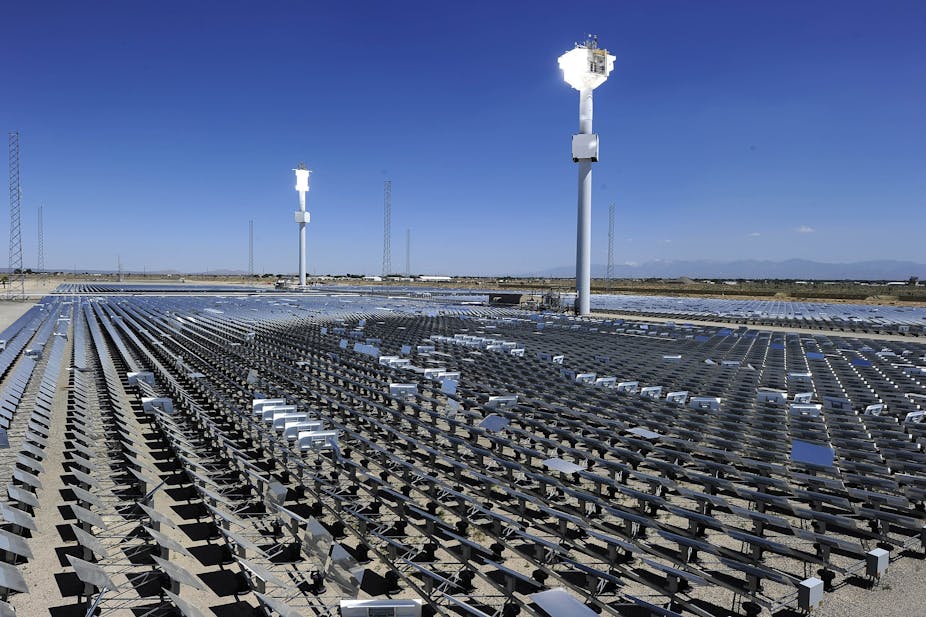Australia has a huge solar energy resource.
Solar collectors spread out over a square 50 km could generate all of Australia’s current electricity demand.
Of course in practice, we would need a mix of renewable energy sources – solar, wind, biomass and, possibly in the longer term, wave and hot rock geothermal – in diverse geographic sites supplying clean and reliable electricity day and night.
With a substantial government program to improve the efficiency of energy use and phase out electric hot water systems, solar photovoltaic (PV) systems on roofs could provide at least half of residential electricity demand.
Solar PV could also make a large contribution to electricity demand in low-rise commercial buildings.
Building the residential market
There are currently two kinds of government policy to build the market for small-scale PV in Australia.
Both are funded by a small increase in electricity prices. The first is the federal government’s Small-Scale Renewable Energy Scheme, which provides certificates for new solar PV (and wind turbines) of generating capacity 1.5 kilowatts (kW) or less.
These certificates have economic value and so can be traded. They diffuse part of the up-front capital cost of PV systems. At present, the design of the scheme has produced a glut of certificates and so their economic value is low.
In addition, most state governments have feed-in tariffs (FiTs) which, in theory, pay premium prices for small-scale residential solar (and wind) electricity fed back into the grid.
In practice, all mainland states except NSW have a “net tariff”, which only pays for the difference between solar electricity fed into the grid and electricity bought from the grid by the household, provided that difference is positive.
Most households receive little, if anything from a net tariff.
The exception is the ACT, with a “gross tariff” that pays for all renewable electricity fed into the grid, regardless of how much electricity the household buys from the grid. It is also the only jurisdiction with FiTs for medium- and large-scale solar systems, although these are tightly capped in terms of total generating capacity to be installed.
Until recently, NSW had an over-generous gross feed-in tariff of 60 cents per kilowatt-hour (c/kWh), which created a short-lived boom in purchases of PV systems.
At the time of writing this article the NSW has terminated FiTs for new systems and has announced that it intends to retrospectively reduce the level of FiTs of existing systems to 40 c/kWh.
Solar retailers and consumers are rallying at these cuts.
Scaling up to industrial-size solar
The residential and commercial sectors are together responsible for about half of Australia’s electricity consumption. Almost the entire other half is industrial.
If this demand were supplied by solar, it would need large solar power stations.
There are two types that could fit the bill:
Concentrated photovoltaic (CPV) power stations. These are fully commercial technologies, in the sense that they are in mass production overseas. Although expensive, they are rapidly declining in price.
Concentrated solar thermal (CST) power stations. Of these, the first generation technologies (parabolic trough) are classified as “pre-commercial”: they are in limited mass production. Second generation technologies (power tower, linear Fresnel and dish) are still at the demonstration stage.
At present, CPV power stations are less expensive than CST, but the latter has a great advantage that could allow it to become the dominant renewable electricity technology in Australia and several other sunny countries before 2030.
The solar collectors of CST power stations concentrate sunlight to produce heat. Part of that heat generates electricity during the daytime and the rest can be stored overnight at low-cost.
So CST can generate 24 hours per day.
Unlike several European countries and California, Australia has no policies to build the market for large-scale solar power.
Plenty of sun, not much enthusiasm
The carbon price, if it is ever introduced, will be too low for at least a decade to assist significantly. At best, there is the ACT’s tiny tranche of FiTs for big solar and the federal government’s modest demonstration programs: Solar Flagships and the Renewable Energy Demonstration Program (REDP).
Flagships will subsidise initially only one large CPV and one large CST power station by 2014.
Cuts to this program in the 2011 federal budget make it unlikely that a second round of grants will be made.
In Flagships, the most likely candidates are proven technologies that have been demonstrated overseas and don’t really need further demonstration here. REDP has awarded grants, under conditions, to build two CST power stations: a dish system at Whyalla, SA, and a Linear Fresnel system at Kogan Creek in Queensland.
Neither Flagships nor REDP meet the principal need of large-scale solar. Large-scale solar needs FiTs: they are needed to build the market for second-generation CST power stations with thermal storage, bring down costs and open up the doorway to a sustainable energy future.
We have an incredible supply of sunshine, a host of technologies that could meet our needs, and a 5% emissions-cut target we need to meet. So why is our commitment to solar so half-hearted?
There is really only one plausible explanation for Australia’s piecemeal and ineffective set of solar policies: the immense political power of Australia’s big greenhouse polluters.
If you want to point a finger, point it at the coal industry.

